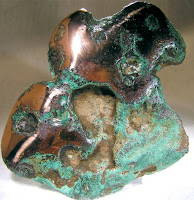In North America, it has been widely accepted that there was no metallurgy anciently; however, that does not mean there was no metal, since copper was abundant in certain areas, especially around the great Lakes and more specifically in Michigan’s Upper Peninsula and north eastern Wisconsin, around the northeast of Lake Michigan along the Keweenaw Peninsula, and surrounding, but especially in the west of Lake Superior.
Map of (yellow dots) ancient copper deposits
and workable copper areas around the Great Lakes. Note the distance from the
Nephite Lands, over 500 miles away—one might wonder what prompted the Nephites
or even the Jaredites to venture completely around Lake Huron and Georgian Bay
to get to Lake Superior to find copper ore
In fact, most ancient copper, though plentiful in the earth, was mostly in the form of low-grade ores that required a sequence of concentration mechanisms to upgrade it to exploitable ore through a series of proto-ores. Copper ores of the oxidized type, including the oxide cuprite and carbonates (malachite) are generally green or blue, and reducible to copper metal by simple heating with charcoal. Ores of the reduced type are sulfides or sulfosalts (chalcocite, chalcopyrite, tetrahedrite), and are not really identified in outcrops of ores and require roasting to convert to oxides, then reduction of oxides to produce metal.
There are a number of places in the world where copper can be found in small deposits in the pure state, but it is usually embedded in a rock matrix, from which it had to be freed only by intensive labor. This is what made the so-called Michigan copper—found around Lake Superior—of such value anciently. This is because early in Earth’s history, there were huge volcanic outflows over the Great Lakes area. As new sediments overlaid these flows, copper solutions were crystallizing in the flood basalts of the lava layers, with the copper crystallizing in nodules and irregular masses along fracture zones a few inches, to many feet wide. After time, four major glaciations ground upon the edges of the old layered basalt lava beds, and exposed some of the embedded copper, which eventually became easily and apparent, resulting in its availability to the ancient inhabitants of the area (Jay Stuart Wakefield, Michigan Copper: Isle Royale and Keweenah Peninsula, 2011; Roy Ward Drier and Octave Jospeh Du Temple, Prehistoric Mining in the Lake Superior Region, Calumet, Michigan, 1961).
As mentioned earlier, the latest glacial period had resulted in the scouring of copper bearing rocks. Once the ice retreated, these were readily available for use in a variety of sizes. Because of the 99.5% purity of the “Michigan-Copper,” there was really very little to be gained by smelting” (Susan R. Martin, Wonderful Power: The Story of Ancient Copper Working in the Lake Superior Basin,” Great Lakes Books Series, Wayne State University Press, 1999).
13-oz nugget of
native copper, Keweenaw County, Michigan, in the Upper Peninsula, where copper
metal (native copper) rather than cooper oxides or sulfides copper ore
The only Mississippian culture (800 to 1600 AD) site where a copper workshop has been located by archaeologists is Cahokia in western Illinois (James A. Brown, professor of archaeology at Northwestern University, Chicago and John Kelly, archaeologist at Washington University, St. Louis). Excavations of the copper workshops indicate copper was worked there. Numerous copper fragments as well as ashes from fires were found in the area as well as the remains of three tree stumps thought to have been used to hold anvil stones used for beating out the flattened sheets of copper.
Native copper was also used in the prehistoric inhabitants of Lac Seul in the Canadian boreal forest of northern Ontario (Bradley G. Hyslop and Alicia J.M. Colson, “Investigations into the interior of Canada’s boreal forest, Lac Seul,” North American Archeologist, vol.38, Iss.4, 2017, p317).
Copper was traditionally regarded as sacred by many historic period Eastern tribes. Copper nuggets are included in medicine bundles among Great Lakes tribes and found even as late as the 19th century among the Muscogee Creeks with a catch of copper plates carried along the Trail of Tears and regarded as some of the tribe's most sacred items. As far south as Tucaloosa, Alabama, ancient mace-shaped copper headdress ornaments have been found, with extensive amounts of imported luxury goods, such as copper, mica, galena, and marine shells, excavated from the site, now housed in the Moundville Archaeological Museum.
Left: Native copper hammered and embossed; Right: Indigenous mound builders in the U.S. Heartland with native copper ornaments
This included not only hammering and shaping native copper into objects, but also embossing copper, as many artifacts have shown, which involved the technique of creating designs in the metal through stamping, piercing, folding or hammering.
However, it does mean these artifacts were not worked and alloyed with other metals under metallurgical practices or principles.
It only means that the ancient North Americans did not alloy metals, thus did not know metallurgy. That they knew hammering, shaping, and even embossing, is well understood; however, there has never been any evidence of actual metallurgy—the smelting of metals, melting to a liquid, mixing with other smelted, liquefied metals for form an alloy—has never been found in ancient North Americas.
(See the next post, “Metallurgy in the Americas – Part IX,” regarding the fact that almost all metallurgists claim that metallurgy developed and began in South America and from there traveled northward into Central, Meso-, and North America)







No comments:
Post a Comment